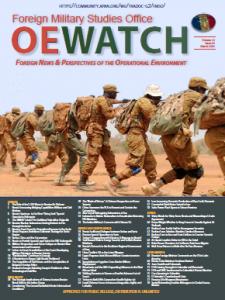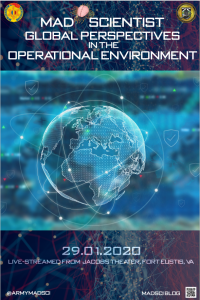 [Editor’s Note: Today’s post is excerpted from last month’s (March 2020) edition of the OE Watch, which in turn analyzes two articles from Jiefangjun Bao (the People’s Liberation Army [PLA] Daily), published earlier this year.
[Editor’s Note: Today’s post is excerpted from last month’s (March 2020) edition of the OE Watch, which in turn analyzes two articles from Jiefangjun Bao (the People’s Liberation Army [PLA] Daily), published earlier this year.
The … Read the rest

… Exploring the Operational Environment
 [Editor’s Note: Today’s post is excerpted from last month’s (March 2020) edition of the OE Watch, which in turn analyzes two articles from Jiefangjun Bao (the People’s Liberation Army [PLA] Daily), published earlier this year.
[Editor’s Note: Today’s post is excerpted from last month’s (March 2020) edition of the OE Watch, which in turn analyzes two articles from Jiefangjun Bao (the People’s Liberation Army [PLA] Daily), published earlier this year.
The … Read the rest
[Editor’s Note: Mad Scientist Laboratory is pleased to publish today’s post by guest bloggers Colonel Montgomery Erfourth and Dr. Aaron Bazin, addressing prospective patterns of emerging technology used in the 2020-2027 timeframe by Violent Extremist Organizations (VEOs), as … Read the rest
 [Editor’s Note: Mad Scientist would like to thank everyone who participated in the Mad Scientist Global Perspectives in the Operational Environment Virtual Conference on 29 January 2020 — from our co-hosts at the Army Futures Command (AFC) and the … Read the rest
[Editor’s Note: Mad Scientist would like to thank everyone who participated in the Mad Scientist Global Perspectives in the Operational Environment Virtual Conference on 29 January 2020 — from our co-hosts at the Army Futures Command (AFC) and the … Read the rest
[Editor’s Note: Mad Scientist Laboratory is pleased to publish today’s post by returning guest bloggers LTC Arnel P. David, LTC (Ret) Patrick James Christian, PhD, and Dr. Aleksandra Nesic, demonstrating once again the power of a … Read the rest
[Editor’s Note: Like many of our readers, Mad Scientist Laboratory is starting off the new year with a bit of introspection…. As we continue to focus on the Operational Environment (OE) and the changing character of warfare, we find … Read the rest